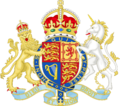President of the Board of Trade facts for kids
Quick facts for kids United KingdomPresident of the Board of Trade |
|
|---|---|

Royal Arms as used by His Majesty's Government
|
|
| Board of Trade UK Export Finance |
|
| Style | The Right Honourable (Formal prefix) President of the Board of Trade |
| Member of | British Cabinet Privy Council |
| Reports to | The Prime Minister |
| Seat | Westminster, London |
| Appointer | The Sovereign on advice of the Prime Minister |
| Term length | No fixed term |
The President of the Board of Trade is a very important role in the United Kingdom government. This person leads the Board of Trade, which is a special committee of the Privy Council. The Board of Trade helps manage and promote trade for the country. It started a long time ago, in the 17th century, as a group that looked into trade matters. Over time, it grew into a full government department with many different tasks. The person currently holding this position is Jonathan Reynolds, who also serves as the Secretary of State for Business and Trade.
The History of the Board of Trade
The idea of having a special group to focus on trade first came about in 1655. A leader named Oliver Cromwell created a committee. He asked his son, Richard Cromwell, to lead this group. It included important people like Lords, judges, and merchants. Their job was to think of ways to help trade grow.
Later, in 1660, King Charles II set up a Council of Trade. Soon after, he created another council for foreign plantations. These two groups worked separately for a while. Then, in 1672, they joined together to form the Board of Trade and Plantations.
The Board was set up again in 1696. It had many members, including important government officials and other experts. The main leader of this group was called the President of the Board. This role was often known as the First Lord of Trade.
In 1782, the Board was officially closed. However, a new committee was quickly formed in 1784 to do similar work. By 1786, a new, more focused committee was created. This new group concentrated mainly on business and trade. At first, the President of the Board of Trade did not always attend the Cabinet meetings. But by the early 1800s, it became a very senior position, usually part of the Cabinet.
Over the years, the role of the President of the Board of Trade has changed. It has adapted to the needs of the country's economy and international trade. Today, it remains a key position in the British government.
Images for kids














